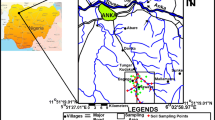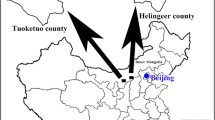Abstract
The aim of this study was to investigate the heavy metal content in the hair of children living near non-ferrous metal mines located in the urban settlements of Baymak, Sibay and Uchaly of the Republic of Bashkortostan, Russia, and in the soils obtained from the same area. The hair and soils samples were examined for the presence of the following metals: copper (Cu), zinc (Zn), iron (Fe), cobalt (Co), nickel (Ni), manganese (Mn), lead (Pb) and cadmium (Cd). The results of the study showed there to be increased levels of Cu (4.4-fold), Zn (7.9-fold) and Cd (2.5-fold) in soil samples which were exceeded the maximum permissible concentration (MPC). Mineral analysis of the hair samples was performed using a combination of atomic emission spectrometry and inductively coupled plasma mass spectrometry. Comparison of the data on hair from this study with the average reference data for Russia showed there to be an excess of Zn and Mn in the hair samples of the majority of the studied population: 50.0 and 48.8%, respectively. In addition, we observed an excess of Fe, Cu and Ni in a small number of children (23.3, 21.6 and 15.5% of the studied population, respectively). Deficiencies in Co and to a lesser extent in Zn, Cu, Fe, essential microelements for human health, were found in 55.2, 19.0, 19.8 and 15.5% of the studied population respectively. The results of this study could be used for biomonitoring of the extent of heavy metal burden in people living in contaminated areas.
Access this chapter
Tax calculation will be finalised at checkout
Purchases are for personal use only
Similar content being viewed by others
References
Abakumov EV, Suyundukov YT, Pigareva TA, Semenova IN, Khasanova RF, Biktimerova GY, Rafikova YS, Ilbulova GR (2016) Biological and sanitary assessment of dumps of Sibay quarry of the Republic of Bashkortostan. Hyg Sanitation 95(10):929–934 (in Russian)
Abdrakhmanov RF, Akhmetov RM (2013) Geochemistry of rocks and ground water in the zone of influence of Semenovsk Gold Recovery Factory. The Ufimian Scientific Center, Institute of Geology, Ufa, pp 211–221 (in Russian)
Adelstein SJ, Vallee BL (1961) Copper metabolism in man. N Engl J Med 265(18):892–897. https://doi.org/10.1056/nejm196111022651806
Bakaeva EA, Eremeyshvili AV (2014) Ecological situation and microelement status of children (1–3 years) of the unurbanized territory of the European North of Russia. Ecol Hum 4:34–38 (in Russian)
Belan LN (2005) Medico-biological features of mining regions. Bull Orenburg State University 5:112–117 (in Russian)
Collins JF, Prohaska JR, Knutson MD (2010) Metabolic crossroads of iron and copper. Nutr Rev 68(3):133–147. https://doi.org/10.1111/j.1753-4887.2010.00271.x
Evrenoglou L, Partsinevelou AS, Nicolopoulou-Stamati P (2017) Correlation between concentrations of heavy metals in children’s scalp hair and the environment. A case study from Kifissos River in Attica, Greece. Glob NEST J 19(4):592–600
Fitsanakis VA, Zhang N, Garcia S, Aschner M (2009) Manganese (Mn) and iron (Fe): interdependency of transport and regulation. Neurotox Res 18(2):124–131. https://doi.org/10.1007/s12640-009-9130-1
Geen A, Bravo C, Gil V, Sherpa S, Jack D (2012) Lead exposure from soil in Peruvian mining towns: a national assessment supported by two contrasting examples. Bull World Health Organization, 90(12), 878–886. https://doi.org/10.2471/blt.12.106419
Ghorani-Azam A, Riahi-Zanjani B, Balali-Mood M (2016) Effects of air pollution on human health and practical measures for prevention in Iran. J Res Med Sci 21:65. Published 2016 Sept 1. https://doi.org/10.4103/1735-1995.189646
Godt J, Scheidig F, Grosse-Siestrup C, Esche V, Brandenburg P, Reich A, Groneberg DA (2006) J Occup Med Toxicol 1(1) 22:1–6 https://doi.org/10.1186/1745-6673-1-22
Grabeklis AR, Skalny AV, Nechiporenko SP, Lakarova EV (2011) Indicator ability of biosubstances in monitoring the moderate occupational exposure to toxic metals. J Trace Elem Med Biol 25:S41–S44. https://doi.org/10.1016/j.jtemb.2010.10.014
Gres NA, Yuraga TM, Romanyuk AG, Hamad S, Sokol VP (2012) Comparative performance evaluation of informative biochemical and atomic-emission studies macro content of trace elements in blood, urine and hair of healthy and patients with urolithiasis. Lab Diagn Eastern Europe 4(04):62–72 (in Russian)
Harris ED (2009) Copper homeostasis: the role of cellular transporters. Nutr Rev 59(9):281–285. https://doi.org/10.1111/j.1753-4887.2001.tb07017.x
He ZL, Yang XE, Stoffella PJ (2005) Trace elements in agroecosystems and impacts on the environment. J Trace Elem Med Biol 19(2–3):125–140
Jenkins DW (1979) Toxic trace metals in mammalian hair and nails. U.S. Environmental Protection Agency, Las Vegas, Nevada, EPA-600/4-79-049
Kabata-Pendias A, Mukherjee A (2007) Trace elements from soil to human. Springer, Berlin, Heidelberg, p 561
Karri V, Schuhmacher M, Kumar V (2016) Heavy metals (Pb, Cd, As and MeHg) as risk factors for cognitive dysfunction: a general review of metal mixture mechanism in brain. Environ Toxicol Pharmacol 48:203–213. https://doi.org/10.1016/j.etap.2016.09.016
Lanphear BP, Hornung R, Khoury J, Yolton K, Baghurst P, Bellinger DC, … Roberts R (2005) Low-level environmental lead exposure and children’s intellectual function: an international pooled analysis. Environ Health Perspect 113(7):894–899. https://doi.org/10.1289/ehp.7688
Liu G, Tao L, Liu X, Hou J, Wang A, Li R (2013) Heavy metal speciation and pollution of agricultural soils along Jishui River in non-ferrous metal mine area in Jiangxi Province, China. J Geochem Explor 132:156–163. https://doi.org/10.1016/j.gexplo.2013.06.017
Lönnerdal B (2017) Excess iron intake as a factor in growth, infections, and development of infants and young children. Am J Clin Nutr 106(Supplement 6):1681S–1687S. https://doi.org/10.3945/ajcn.117.156042
Mamtani R, Stern P, Dawood I, Cheema S (2011) Metals and disease: a global primary health care perspective. J Toxicol 2011:1–11. https://doi.org/10.1155/2011/319136
Maximum permissible concentrations (MPC) and tentative-permissible concentrations (TPC) of chemical substances in soil: Hygienic standards (2006), M.: Federal Center for Hygiene and Epidemiology, 15 pp (in Russian)
Menezes-Filho JA, Novaes CO, Moreira JC, Sarcinelli PN, Mergler D (2011) Elevated manganese and cognitive performance in school-aged children and their mothers. Environ Res 111(1):156–163. https://doi.org/10.1016/j.envres.2010.09.006
Nagaev RY (2004) Medical, social and hygienic features of the formation of iron-deficiency States in children living in the region with a developed mining industry, Ufa, 22 p. (in Russian)
Ojuederie O, Babalola O (2017) Microbial and plant-assisted bioremediation of heavy metal polluted environments: a review. Int J Environ Res Public Health 14(12):1504. https://doi.org/10.3390/ijerph14121504
Opekunova MG, Alekseyeva-Popova NV, Arestova IY, Gribalev SV, Krasnov DA, Bobrov DG, Osipenko OA, Solovyeva NI (2001) Heavy metals in soil and plants of the Southern Urals: ecological condition of reference territories. Vestnik of Saint Petersburg Univ 7(31):45–53 (in Russian)
Rafikova YS, Semenova IN, Seregina YY, Khakimzyanov OM (2012) Medico-ecological features of mining regions of the Trans-Urals of the Republic of Bashkortostan. Fundam Res 11(1):43–45 (in Russian)
Rani A, Kumar A, Lal A, Pant M (2013) Cellular mechanisms of cadmium-induced toxicity: a review. Int J Environ Health Res 24(4):378–399. https://doi.org/10.1080/09603123.2013.835032
Reiss B, Simpson CD, Baker MG, Stover B, Sheppard L, Seixas NS (2015) Hair manganese as an exposure biomarker among welders. Ann Occup Hyg 60(2):139–149. https://doi.org/10.1093/annhyg/mev064
Rossiter DG (2007) Classification of urban and industrial soils in the world reference base for soil resources. J Soils Sediments 7(2):96–100
Semenova IN, Rafikova YS, Khasanova RF, YT Suyundukov (2018) Analysis of metal content in soils near abandoned mines of Bashkir Trans Urals and in the hair of children living in this territory. J Trace Elem Med Biol 50:664–670. https://doi.org/10.1016/j.jtemb.2018.06.017
Semenova IN, Rafikova YS, Suyundukov YT (2015) The content of toxic metals in soil and human biosubstrates at the territories of some administrative regions of Bashkortostan, In the book: The role of soils in biosphere and human life. In: International scientific conference: to the 100th anniversary of the birth of academician G. V. Dobrovolsky, to the International Year of Soil. MAKS Press, Moscow, pp 110–112 (in Russian)
Semenova IN, Rafikova YS, Suyundukov YT, Biktimerova GY (2016) Regional peculiarities of microelement accumulation in objects in the transural region of the republic of Bashkortostan. In: Biogenic-abiogenic interactions in natural and anthropogenic systems lecture notes in earth system sciences. Switzerland, pp 179–187
Shao L, Xiao H, Wu D (2013) Speciation of heavy metals in airborne particles, road dusts, and soils along expressways in China. Chin J Geochem 32(4):420–429. https://doi.org/10.1007/s11631-013-0651-1
Skalny AV (2003) Reference values for concentration of chemical elements in hair, obtained by method of ICP-AES (Inductively coupled plasma—atomic emission spectroscopy). Microelements Med 4(1):55–56 (in Russian)
Tchounwou PB, Yedjou CG, Patlolla AK, Sutton DJ (2012) Heavy metal toxicity and the environment. EXS. 101:133–164
Usmanova RK (2009) Features of the clinical and hematological status in rural children, Ufa, 111 p. (in Russian)
Vinogradov AP (1962) The average content of chemical elements in the main types of igneous rocks of the Earth’s crust. Geochemistry 7:555–571 (in Russian)
Wu X, Cobbina SJ, Mao G, Xu H, Zhang Z, Yang L (2016) A review of toxicity and mechanisms of individual and mixtures of toxic metals in the environment. Environ Sci Pollut Res 23(9):8244–8259. https://doi.org/10.1007/s11356-016-6333-x
Acknowledgements
This publication has been supported by the Russian Foundation for Basic Research and the Government of the Republic of Bashkortostan, research projects no: 17-16-02002-OGN OGN-R_URAL-A and 18-413-020004 p_a. We thank Oluwatobiloba Oke, B.Sc. (Hons) for her comments and proofreading which greatly improved the manuscript.
Author information
Authors and Affiliations
Corresponding author
Editor information
Editors and Affiliations
Rights and permissions
Copyright information
© 2020 Springer Nature Switzerland AG
About this paper
Cite this paper
Semenova, I.N., Rafikova, Y.S., Khasanova, R.F., Suyundukov, Y.T. (2020). Heavy Metal Content in Soils and Hair of the Inhabitants Near Copper Zinc Mine (Bashkortostan, Russia). In: Frank-Kamenetskaya, O., Vlasov, D., Panova, E., Lessovaia, S. (eds) Processes and Phenomena on the Boundary Between Biogenic and Abiogenic Nature. Lecture Notes in Earth System Sciences. Springer, Cham. https://doi.org/10.1007/978-3-030-21614-6_45
Download citation
DOI: https://doi.org/10.1007/978-3-030-21614-6_45
Published:
Publisher Name: Springer, Cham
Print ISBN: 978-3-030-21613-9
Online ISBN: 978-3-030-21614-6
eBook Packages: Earth and Environmental ScienceEarth and Environmental Science (R0)




